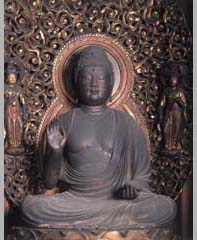. Yakushipedia - ABC-Index 薬師如来 .
. Yakushi Nyorai - Legends from the provinces .
::::::::::::::::::::::::::::::::::::::::::::::::::::::::::::::::::::::::::::::::::::::::::::::::::::::::::::::::::::::::::::::::::::::::::::::::::::::::::::::::::::::::::::::
Yakushi Nyorai 薬師如来 and legends from 京都 Kyoto

勝持寺 Shoo-Ji - お薬摘む薬師
(西国四十九薬師巡礼 Nr. 42)
.......................................................................
. Inaba Yakushi 因幡薬師 Yakushi from Inaba .
Byoodooji 平等寺 Byodo-Ji - 五条高倉薬師堂 Gojo Takakura Yakushi Do .
Medicine Master Buddha: The Iconic Worship of Yakushi in Heian Japan
. Tako Yakushi 蛸薬師 Octopus Yakushi .
Temple 永福寺 Eifuku-Ji
京都市中京区新京極蛸薬師東側町503
京都十二薬師霊場 / 洛陽十二薬師
. Pilgrimage to 12 Yakushi Temples in Kyoto .
kuwagata Yakushi 鍬形薬師 Yakushi with a cut of a hoe
temple 大超寺 Daicho-Ji

The statue was found by a farmer plowing his fields, it shows the impression of his kuwa 鍬 hoe on the back.
..............................................................................................................................................
kane no oto 鐘の音 the sound of the bell
Near the 火葬場 crematory there was a 薬師堂 Yakushi Do Hall. People say there were a lot of gold coins buried there. In a quiet night the sound of a bell was heard from below the Yakushi hall.
kuruma-kaeshi no O-Yakushi san 車返のお薬師さん Yakushi stopped the transport
On orders of the Kamakura government a very precious statue of Yakushi was to be brought to 奥州平泉 Hiraizumi. But on the way at 白糸 Shiraito the cr with the statue on it could not be moved any more. So the people thought that Yakushi had chosen this place for himself and built a hall there to venerate him.
.......................................................................
tsuchinoko hebi 槌の子蛇 hammerspawn
Hammerspawns had been sighted at various spots in Kyoto:
In Northern Kyoto, 雲ケ畑 Kumogabata at the 薬師峠 Yakushi pass, at 沢の池 Sawanoike, at 老ノ坂峠 Oinosaka Pass
. at 京都清滝不動院 Kiyotaki Fudo-In .

Yakushi Tooge 薬師峠 Yakushi Toge pass
. tsuchinoko 槌の子 hammerspawn .
a legendary snake-like cryptid from Japan
- reference : Yakushi Toge in Japan -
..............................................................................................................................................
.......................................................................
亀岡市 Kameoka
Yakushido no kane 薬師堂の鐘 the bell of the Yakushi Do Hall
When villagers buried the bell of the Yakushi Do Hall at the upper waterfall of the river 蛇谷川 Jadanigawa, it begun to rain immediately and the drought was over.
Yakushi Butsuzoo 薬師,仏像
About 200 years ago, during a flooding, a buddha statue came floating down the river. People thought it was Yakushi and venerated it.
Most people in the village stayed healthy after that.
.......................................................................
中京区 Nakagyo
. tengu no tsume 天狗の爪 nails of a Tengu .
shown at Temple 丹州国分寺 Kokubun-Ji
.......................................................................
南丹市 Nantan
薬師如来 Yakushi Nyorai
If people make a wish for healing at the Yakushi Do Hall at the temple 成就院 Joju-In, people hard of hearing will certainly be healed. To show their gratitude, they have to make an offering. They must find a stone with a hole, place a thread or a mizuhiki 水引 ceremonial paper cord around it and offer it.
kyuuri kaji 胡瓜加持 ritual for cucumber purification, cucumber blessing
At the Yakushi Do Hall people come to get a purified cucumber, take it home and each member of the family has to take a bite. The rest will be buried under the beams of the house to prevent people from getting ill during the year.

. kyuuri fuuji きゅうり封じ / 胡瓜封じ cucumber ritual .
.......................................................................
与謝郡 Yosa district 野田川町 Nodagawa
. muchi yakushi 鞭薬師 "whip Yakushi" .
麻呂子親王 Prince Maroko Shinno carved seven statues of Yakushi Nyorai ...
..............................................................................................................................................
- - - - - Legends from other prefectures, related to Kyoto
.......................................................................
Aichi 愛知県 / 名古屋市 Nagoya 熱田区 Atsuta
. 大薬師の鬼祭 "Festival of the Demons of Yakushi Nyorai" .
高蔵不動院 Takakura Fudo-In
.......................................................................
Shimane 島根県 / 邇摩郡 Nima district
. Yakushi no men 薬師の面 mask of Yakushi .
at the tempel 山田寺 Yamadadera
.......................................................................
Wakayama 和歌山県 / 日高郡 Hidaka district みなべ町 Manabe
O-Ryuu Yanagi おりゅう柳 The Willow Tree O-Ryu
. Sanjusan Gendo Hall and 柳のお加持 "Rite of the Willow" .
and the legend of O-Ryu.
A willow tree from 熊野川町 Kumanogawa village had been cut down and should be shipped to Kyoto for the building of the Sanjusan Gendo Hall.
The tree was very large and could not float down the river smoothly. There appeared the spirit of a woman and helped pulling the tree downriver. But the place where the tree had been cut was now cursed
and the villagers venerated 十二薬師 12 Yakushi statues there.
..............................................................................................................................................
- reference : Nichibun Yokai Database -
::::::::::::::::::::::::::::::::::::::::::::::::::::::::::::::::::::::::::::::::::::::::::::::::::::::::::::::::::::::::::::::::::::::::::::::::::::::::::::::::::::::::::::::

Tooji 東寺 To-Ji - Yakushi Do Hall
::::::::::::::::::::::::::::::::::::::::::::::::::::::::::::::::::::::::::::::::::::::::::::::::::::::::::::::::::::::::::::::::::::::::::::::::::::::::::::::::::::::::::::::
- - - - - More temples with statues of Yakushi Nyorai in Kyoto
一様院 Ichiyo-In, 大宮薬師山東町16
神護寺 Jingo-Ji, 高雄山 Takao-San
教王護国寺 Kyoo-O Gokoku-Ji
来迎院 Raigo-In
三宝院 Sanbo-In, 醍醐寺 Daigo-Ji 塔頭 三宝院
- reference source : yaokami.jp/kyoto -
::::::::::::::::::::::::::::::::::::::::::::::::::::::::::::::::::::::::::::::::::::::::::::::::::::::::::::::::::::::::::::::::::::::::::::::::::::::::::::::::::::::::::::::

Join the friends on facebook !
. Yakushipedia - ABC-Index 薬師如来 .
. Yakushi Nyorai - Legends from the provinces .
. Yakushi Nyorai Pilgrimages 薬師霊場巡り - Introduction .
. O-Mamori お守り Amulets and Talismans .
. Japan - Shrines and Temples - ABC List .
[ . BACK to DARUMA MUSEUM . TOP . ]
[ . BACK to WORLDKIGO . TOP . ]
- - - #yakushilegendskyoto #kyotoyakushi - - -
::::::::::::::::::::::::::::::::::::::::::::::::::::::::::::::::::::::::::::::::::::::::::::::::::::::::::::::::::::::::::::::::::::::::::::::::::::::::::::::::::::::::::::::




































